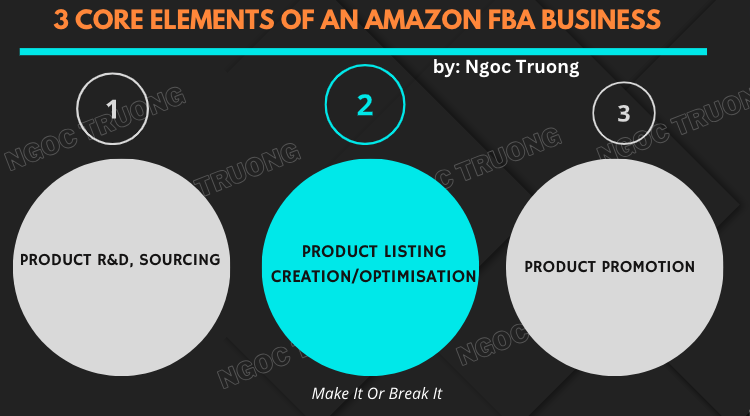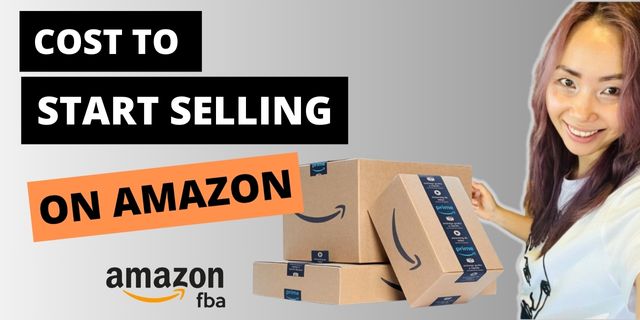Here’s a snapshot of the startup costs for selling on Amazon, with the assumption that you’ll be selling in the North America region and primarily focusing on the US marketplace. The costs should be fairly similar if you plan to sell in other regions, such as the UK, Germany, or Australia.
- Product Sourcing: $800 – $1,000
- Sample Costs: $70 – $200
- Amazon Professional Account Subscription: $39.99
- Listing Creation: $400 – $600
- Shipping to Amazon FBA: $300
- PPC Advertising: $300
Total Estimated Launch Cost: $1,800 – $2,400
Now, let’s delve into each of the cost components above to have better understanding of why and how they occur.
1. Product Sourcing: $800 – $1,000
Initial orders usually range from 100 to 200 units, depending on your goal and budget. If your order include some basic customization, like a logo, the estimated cost per unit might be around $4. However, this is just an estimate; the actual cost per unit could vary, more or less than $4, based on the product.
At the same time, some suppliers will have Minimum Order Quantity (MOQ).
What is MOQ?
MOQ is the smallest product quantity that a supplier is willing to accepts for an order. A few suppliers will stick with their MOQ. At the same time, MOQ can be negotiable with many of them.
You’ll be able to secure the first order at the desired price and quantity with an effective communication and negotiation strategy with suppliers. At this juncture, I normally provide detailed guidance to my students, including scripts for reaching out to suppliers, requesting quotes, negotiating prices, and managing the initial test order.
First Order Estimate
Let’s use 200 units for a reasonable estimate. The total cost will be: $4 x 200 units = $800.
It’s advisable to budget approximately $1,000 for the cost of goods for your initial order to account for any unforeseen expenses.
Cost For A Product Sample
It’s crucial to obtain a sample from the supplier you’re considering for your first 200-unit order. Without any customizations, the primary expense for a sample typically revolves around the shipping fees, especially if it’s coming from China. When you add customizations like a logo or specific sizing, you can expect extra charges on top of the shipping costs.
Generally, the price for acquiring a sample can vary between $70 and $200. Remember, this is a rough estimate; the actual cost will hinge on your unique requirements and circumstances.
2. Professional Seller Account Subscription Fee: $39.99/month
Opening an Amazon seller account is a more straightforward process now than it was previously. I’ll write a detailed article on how to apply and get approved for a seller account on Amazon.
Once your account is set up and you’re ready to introduce your first product, you have the option to subscribe to the Professional selling plan for $49.99 per month, by switching from the free Individual selling plan.
Therefore, you should be prepared to pay $49.99 monthly for the subscription fee whenever you switch to the Professional selling plan.
To understand what Amazon fees will incur when you start selling, click here to read this article to understand all fee components for every unit sold as well as fees related to sending products to Amazon FBA and storing products at Amazon fulfilment centres.
3. Build Your First Listing: $400 – $600
Creating your first product listing is a critical phase, where you make it or break it. No matter the quality of your product, if your listing isn’t optimized with high-quality visuals (photos and videos), compelling copy, and a proper SEO backend, you risk losing significant revenue and potentially failing to make sales at all. That’s why I wrote the book: “Zero to Bestseller: How to Build a 7-Figure Amazon Listing from Day One” to share my research and real experience of how to build a high-converting product listing form the get go. View the book here.

To list your product on Amazon, here’s what you’ll need:
3.1) Acquire a UPC from GS1
This will cost you $30. This step is vital, as a proper UPC ensures your product isn’t removed from Amazon listings due to noncompliance.
What is UPC?
The Universal Product Code (UPC) is a unique identifier for products, globally recognized and used across multiple platforms. Once assigned to your product, the UPC is exclusively yours, allowing you to list your product on various marketplaces.
It’s important to select the right purchase option and register your information with GS1 accurately. For detailed guidance, refer to my specific video below on obtaining a UPC correctly.
3.2) Create Product Photos: $350
Let’s give your Amazon listing a winning edge with show-stopping photos! Amazon lets you flaunt up to nine pictures, but even many big sellers still stick with seven. A number of my listings still have only seven photos. Starting with seven is great, but why not dial it up to nine and show off all the cool aspects of your product? It’s like getting extra real estate for free!
You’ll first have to decide what photos to show in your listing. I’ve detailed 12 of the most effective product photo styles that top Amazon listings use in my book Zero to Bestseller: How to Build A 7-Figure Amazon Listing From Day One. These include essential shots like the specification photo, which showcases your product’s details. Your main photo is also crucial—it’s the front runner that not only boosts your listing’s ability to convert browsers into buyers but also draws in those all-important clicks, driving traffic to your page.
How to get product photography done?
For getting your product photos done, you’ve got a couple of solid options:
- Do it yourself. This is rarely the case as most of us don’t have skills to do it effectively.
- Go for freelancers on platforms like Fiverr or Upwork.
- Partner with an ecommerce marketing agency.
The cost will vary based on several factors, including the photographer’s location, their level of experience, and their marketing savvy. In my book, I dive into how to pick the right photographer and set realistic expectations—I lay out the whole process to ensure you get those perfect shots for your Amazon listing. Click here to check out the book.
If you’re just starting out and watching your budget, around $350 is often enough to get a set of professional, high-quality photos. Don’t be fooled into thinking the most expensive option is the best—what matters is value and effectiveness. For a comprehensive guide on crafting photos and videos that really sell without breaking the bank, my book is the resource you need. It’s quite a read, so I’ve saved the full rundown for those pages.
How much did I pay for product photography of my first listing on Amazon?
When I started out, I hired an agency based in the Philippines who was experienced in creating product photos for e-commerce, particularly for Amazon listings, at 500 USD. That’s all I paid to build a product listing.
Then, when my product started selling well, I registered a trademark for it and created a video using a photographer that I found on Fiverr. The video had very high engagement and was one of the best ones in the category on the Amazon US marketplace at the time.
3.3) Adding A Product Video: $200 – $300
If you want to do a product video, your budget might stretch from $550 to $650 for both photos and a video. Prices can vary, but with the right know-how, this range should set you up for success.
In my book, Zero to Bestseller: How to Build A 7-Figure Amazon Listing From Day One, I listed out 8 types of product videos that will help increase your listing conversion rate and boost sales.
To decide how long the video should be, watch my video below of best product video length for high engagement.
3.4) Write Listing Copy: $0 – $70
If you tackle the listing copy yourself, then it doesn’t cost you anything. I’ve always written listing copy myself since my early days in Amazon FBA when ChatGPT wasn’t born yet, until now.
Alternatively, platforms like Fiverr or Upwork have plenty of skilled copywriters familiar with Amazon’s specifics, usually charging between $30 to $100. On average, you might spend about $70 for their services.
4) Send Products To Amazon FBA: $300
Shipping costs are based on either volumetric weight or actual weight, depending on which one is greater. Most of time, shipping fees will be based on volume weight rather than actual weight for Amazon FBA products.
How to calculate volume weight?
Volumetric weight is calculated by multiplying the height, width, and length of a package (in centimeters for Chinese forwarders) and then dividing by a dimensional weight divisor, commonly 6,000.
Volumetric Weight (kg) = [Height (cm) × Width (cm) × Length (cm)] / 6,000
Using the above formula, you’ll get volume weight of a carton or box.
Some forwarders might use a different divisor, like 5,000, which can significantly affect the cost, so it’s crucial to confirm their method of calculation before shipping.
Additionally, ask about any potential adjustments they may make to the package dimensions, which can alter the volumetric weight and, consequently, the final cost.
You can also use online volumetric weight calculators —there are several available for free.
When shipping by ocean, you’ll likely opt for DDP.
What is DDP in shipping terms?
DDP, or Delivery Duty Paid, is a shipping term where the forwarder assumes all the responsibility and costs of transporting goods until they reach the destination, including paying for shipping costs, export and import duties, insurance, and any other expenses incurred during shipping.
Ocean vs. Air shipping
Ocean shipping will be slower than Air shipping. If time is of the essence, Air Express, also available as DDP, is faster but costs substantially more—expect to pay about 3.5 to 5 times the price of ocean freight.
Ocean freight costs generally vary from $1 to nearly $2 per kilogram, depending on the cargo size. Larger shipments typically mean lower costs per kilogram. Please note that the above per-kg cost is just an estimate. For accuracy, talk to your forwarder.
For example, suppose you’re shipping four boxes, each measuring 60 x 54 x 36 cm, containing a total of 200 units. The volumetric weight for each box is calculated as follows:
For four boxes, the total volumetric weight would be:
19.44 kg × 4 = 77.76 kg
Rounded up, this is usually considered as 78 kg by shipping companies.
Remember to account for a potential increase in volume weight, about 15% to 25%, after the forwarder’s assessment at their warehouse. This would adjust our 78 kg to approximately 98 kg (78 kg x 1.25 = 98 kg) for total chargeable volume weight.
- So, for ocean freight under DDP terms, the total cost might be:
98 kg × $1.6/kg = $156
- For Air Express DDP, the total cost could be:
98 kg × $5.8/kg = $568
In short, keep aside about $300 or more for shipping.
